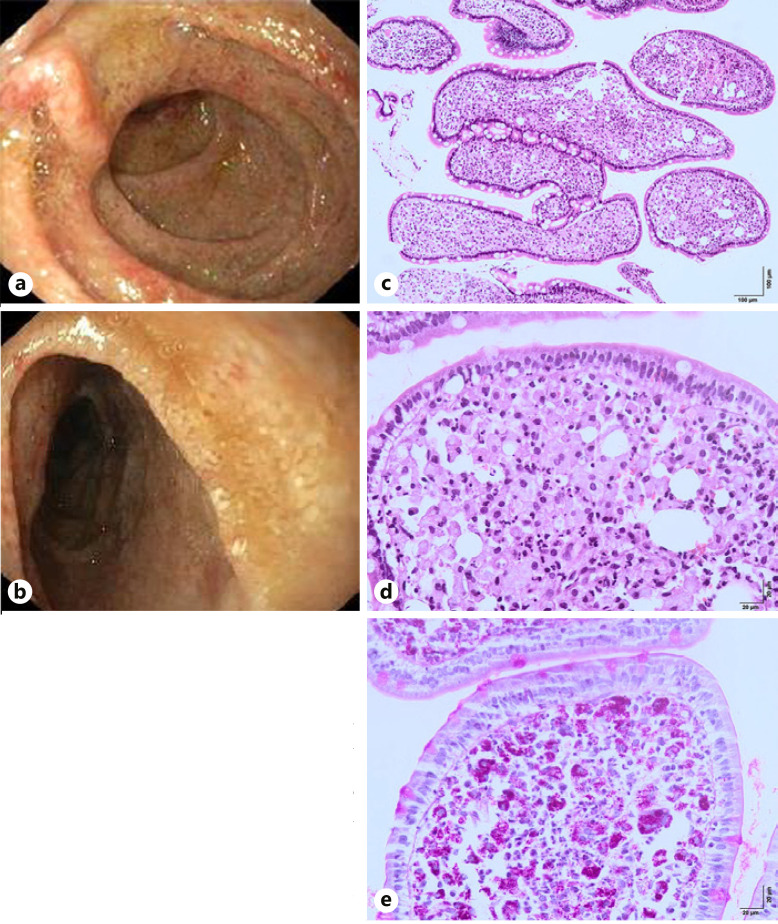惠普尔病累及结肠:罕见的内窥镜记录。
IF 1
Q4 GASTROENTEROLOGY & HEPATOLOGY
引用次数: 0
摘要
本文章由计算机程序翻译,如有差异,请以英文原文为准。


Whipple's Disease with Colonic Involvement: A Rare Endoscopic Documentation.
A 78-year-old woman presented with watery diarrhea and weight loss – 20 kg, 33% of body weight – in the previous 5 months. She denied fever or relevant epidemiological context. Her previous history was unremarkable. Blood analysis showed anemia (hemoglobin 8.4 g/dL), leukocytosis with neutrophilia and high C-reactive protein (73.8 mg/L). Fecal analysis was negative for microbiological, parasitological and Giardia presence; fecal calprotectin was unchanged. Magnetic resonance enterography described normal small bowel and colon appearance, mesenteric fat densification and prominent mesenteric ganglia. Upper endoscopy revealed enlarged duodenal folds, lymphangiectasias, focal hyperemia and friability of the duodenal mucosa (Fig. 1a, b). Ileocolonoscopy revealed continuous edema, hyperemia and friability of the distal ascending colon, associated with erosions and superficial ulcers, as well as a reduced distensibility (Fig. 2b, c). There were no endoscopic alterations in the remaining segments, including the terminal ileum (Fig. 2a). Histological examination of duodenal (Fig. 1c–e), ileal and ascending colonic samples (Fig. 2d–f) identified the presence of foamy macrophages, with periodic acid-Schiff (PAS)positive intracytoplasmic granules, which were Ziehl-Neelsennegative. Despite having no clinical neurological involvement, Tropheryma whipplei DNA was detected in the cerebrospinal fluid (CSF). The patient completed a 14-day course of once daily 2 g intravenous ceftriaxone, followed by a 12-month course of twice daily 800 + 160 mg oral trimethoprim-sulfamethoxazole, which is currently under way. Diarrhea resolved in the first weeks of antibiotic therapy, and full weight recovery occurred after 4 months.
求助全文
通过发布文献求助,成功后即可免费获取论文全文。
去求助
来源期刊

GE Portuguese Journal of Gastroenterology
GASTROENTEROLOGY & HEPATOLOGY-
CiteScore
1.60
自引率
11.10%
发文量
62
审稿时长
21 weeks
期刊介绍:
The ''GE Portuguese Journal of Gastroenterology'' (formerly Jornal Português de Gastrenterologia), founded in 1994, is the official publication of Sociedade Portuguesa de Gastrenterologia (Portuguese Society of Gastroenterology), Sociedade Portuguesa de Endoscopia Digestiva (Portuguese Society of Digestive Endoscopy) and Associação Portuguesa para o Estudo do Fígado (Portuguese Association for the Study of the Liver). The journal publishes clinical and basic research articles on Gastroenterology, Digestive Endoscopy, Hepatology and related topics. Review articles, clinical case studies, images, letters to the editor and other articles such as recommendations or papers on gastroenterology clinical practice are also considered. Only articles written in English are accepted.
 求助内容:
求助内容: 应助结果提醒方式:
应助结果提醒方式:


